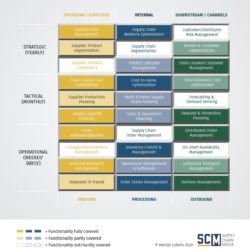Free end-to-end supply chain self-assessment

Supply Chain Media has developed a practical self-assessment tool for end-to-end supply chain visibility. It’s particularly useful for companies during the current corona pandemic because it enables them to screen their entire supply chain. The free downloadable assessment consists of an easy-to-use spreadsheet comprising 30 cells, with three yes/no questions per cell. These cells address the entire end-to-end supply chain: upstream, internal and downstream, and at the operational, tactical and strategic level. If all three questions in a cell are answered with ‘yes’, it means the necessary functionality is fully implemented. If none are answered with ‘yes’, the cell is left blank to highlight the gaps.
The self-assessment tool for end-to-end (E2E) supply chain visibility has been developed in response to requests by – and in close collaboration with – leading multinationals. It distinguishes between the upstream chain, the internal chain and the downstream chain. It shows that visibility not only relates to transport, but also to things like market demand, production capacity, inventory, costs and risks.
“Visibility is about more than just tracking & tracing – that’s operational visibility’, explains Martijn Lofvers, Chief Trendwatcher at Supply Chain Media and publisher of the quarterly magazine Supply Chain Movement. “For a high-tech company like ASML, for example, it’s important to have insight into the financial stability of its suppliers. They mustn’t be so dependent on ASML’s business that they risk immediately going under if there’s a brief decline in orders. That’s strategic visibility,” says Lofvers.
Blind spots
Companies can use the framework to uncover their blind spots. These can vary considerably from one company to another, according to Lofvers, but there are some general similarities: “For example, we’ve noticed that few companies are actually implementing demand sensing, even though it can help them to improve their forecasting. And most companies still don’t have real insight into the cost to serve. They don’t know what it currently costs them to fulfil an order, let alone being able to improve on that.”
Start-ups
Once they have identified their blind spots in supply chain visibility, how can companies tackle them? Lofvers has a tip: “Look at start-ups that offer solutions for those specific blind spots. Existing software vendors often offer a broad portfolio of solutions, the majority of which are unnecessary. Start-ups, on the other hand, are often good at one specific thing. The blind spots highlight those areas in which it can be interesting to cooperate with start-ups.”
Find other self-assessments of Supply Chain Movement here >>










